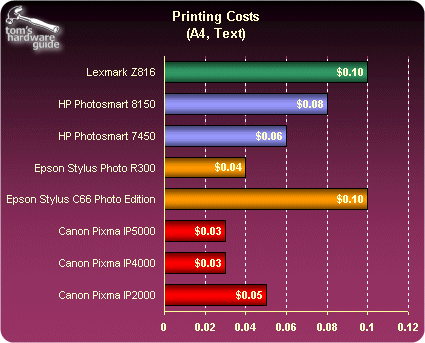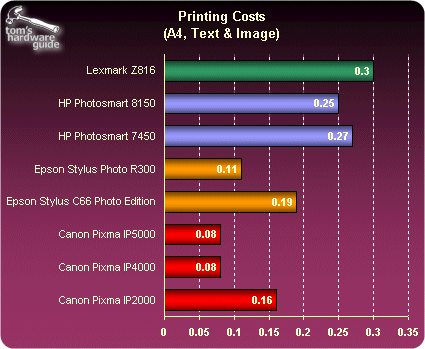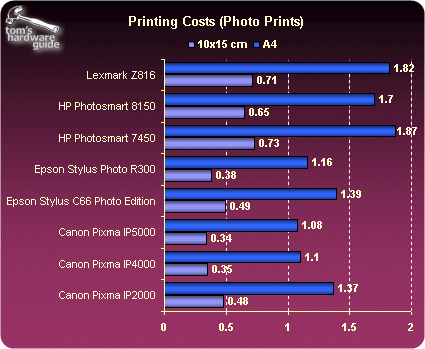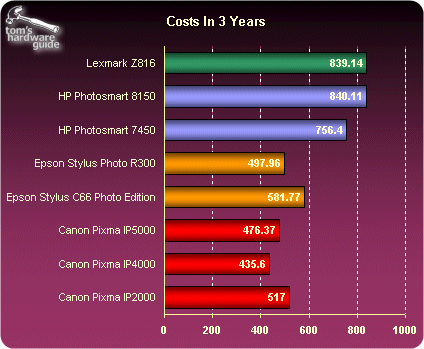In Living Color: 8 New Inkjet Printers Put to the Test
Cost Per Page
Manufacturers haven't agreed on a universal way of calculating cost per page; each uses its own formulas and arguments, which makes it impossible to compare claims in this area. So, using a lot of patience and many reams of paper, we've made our own estimates. Remember that they are indeed estimates, corresponding to a specific usage pattern; results will vary from one user to another. Using the same test method for all models does provide us with a basis for comparing the printers, however.
Cost Of Printing Text
Our first cost-of-use test involved printing text pages with the following attributes:
- Black only
- Standard quality
- Ink coverage rate of 5%
In this area, it comes as no real surprise that the printers that cost the most to buy are the ones that are most economical to use. The Canon Pixma iP4000 and iP5000 and the Stylus Photo R300 models are particularly economical for two reasons: the black cartridge has a high capacity, and its price is reasonable. At the other extreme, the Photosmart 8150 shows a cost of 9 cents per page of text due to the high cost of the cartridge and its short life span. The worst result was with the Lexmark Z816; its black cartridge lasts a very short time, and comes at a price that can't really be called reasonable.
Cost Of Mixed Text/Image Printing
In our second test, we printed pages containing both text and images, as follows:
- Color
- Standard quality
- Ink coverage rate of 25%
If the differences were significant for the cost of printing text, they're nothing compared to what happens once color enters the picture. Between the most economical, the Pixma iP5000 from Canon, and the costliest, the Lexmark Z816, the ratio is nearly a factor of 4 times.
Get Tom's Hardware's best news and in-depth reviews, straight to your inbox.
The Pixma iP5000 seems to get good results from its nozzles and their 1picoliter droplets, which save ink, and thus increase the life of the cartridges. This printer's cyan cartridge ran dry after printing nearly 300 A4 sheets (cyan accounting for 25% of the coverage), which is remarkable. The Pixma iP4000, which uses 2-picoliter droplets, was just behind it. The two HP models are most disappointing in this area, due to the high cost of their cartridges.
Cost Of Photo Printing
In our final test we printed photos with these characteristics:
- 4x6" and A4 size
- High quality
- Ink coverage rate of 100%
The differences may initially seem less great in photo mode than in other modes, but this is simply because in this area we've also counted the cost of paper, which is far from negligible. We've added 28 cents for a 4x6" print and 90 cents for an A4 print, which is an average price we calculated based on the price of papers from several manufacturers.
The models that come out best in the comparison are the ones that use separate color cartridges: the Canon Pixma iP4000, iP5000, and the Stylus Photo R300 (the same winners as in the mixed text/image test). We did note good results from the Pixma iP2000 despite its single cartridge, due to its very attractive price ($18.50, as opposed to $34.99, for example, for the Photosmart 7450's color cartridge, which also has less longevity). It's also more economical to use than the Stylus C66 Photo Edition, despite the fact that the latter uses separate inks. Three models are well behind the pack: the two Photosmarts and the Lexmark Z816. The first two score poorly because of the price of the cartridges, the third due to its limited life span.
Indication Of Cost Of Use Over Three Years
To calculate the total cost of use over three years (which will correspond more or less to your printer's life expectancy), we've added up the purchase cost and the cost of printing at a somewhat heavy annual rate of use: 500 pages of A4 text, 300 A4 mixed color/text pages, 100 4x6" photos, and 20 A4 photos. Again, the choice we've made is arbitrary, but it allows the printers to be compared to each other.
The results show that an inkjet printer costs a lot of money over time. Manufacturers of inkjet printers make their money almost exclusively from consumables, which means they are in some ways like the makers of gaming consoles (who earn more from game titles than the console itself) or telephony operators (who fill their pockets with subscription fees and not profits from telephones).
In this area, HP comes out well if you consider both their market share and the cost of their printers. At the other extreme, Canon proves to be quite economical, even for its single-cartridge model, the Pixma iP2000. Epson is a mixture of both. You'll have to make a choice between the Stylus Photo R300, which is a good investment over the long term, and the Stylus C66 Photo Edition, which is economical to buy but expensive to run. As for the Lexmark Z816, let's just say that cost of use is not a criterion that will win it purchasers.



